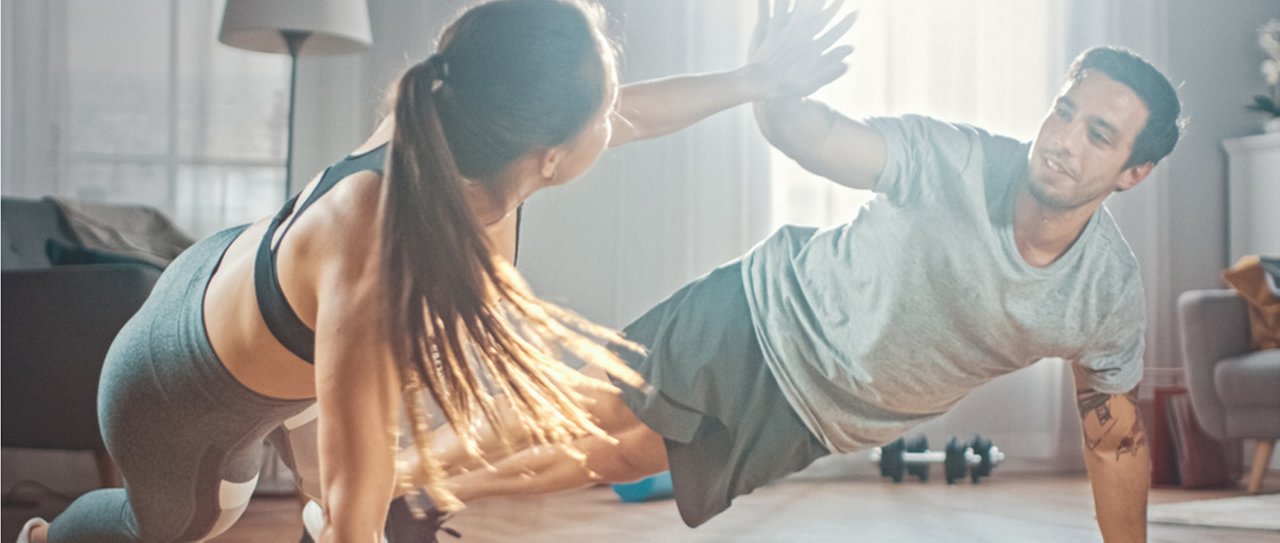How beginners of all ages and abilities can build strength

When you think of strength training, does a bodybuilder’s bulging biceps and ripped bod immediately come to mind? It seems there are misconceptions on what strength training is, and why it matters for “the rest of us” whether we do it.
The first thing to know is that strength training isn’t the same thing as the sport of bodybuilding (that’s a very specific type of training, which I won’t be getting into here), so let’s let that visual go. Nor is strength training only useful in order to attain a certain physique. The fact is, strength is vitally important for all of us – from young people to the very oldest.
Why it matters: Strength training benefits your body and mind
- Use it or lose it! A decline in strength leads to weakness and fragility. Strength training helps prevent age-related muscle and bone loss that starts as early as age 30.
- Helps to burn fat. Stronger muscles increases your metabolism so that your body is burning more calories around the clock.
- Gives you better posture.
- Improves your balance, which helps prevent falls and injuries.
- Prevents or reduces the pain and discomfort that comes from being sedentary.
- Improves your ability to do all of your activities of daily living, such as being able to go up and down stairs, household chores, yard work, or lifting a child.
- Increases your muscular strength and endurance. You’ll experience all the benefits of becoming more fit, such as more stamina and less stiffness.
- Helps improve your overall health. It’s been shown to help reduce resting blood pressure, prevent or improve type 2 diabetes, improve blood lipid profiles, prevent or improve arthritis symptoms, reduces the risk of some types of cancer, and more.
- Builds bone to make your bones stronger, which can help prevent fractures and osteoporosis.
- It’s even great for your brain and mental health.
- Becoming stronger helps you feel more confident and empowered.
I could go on, but I think you get the idea. There’s no down side to being healthy and fit. When you feel your best, it positively impacts your everyday life in every way.
Making exercise a regular part of my day changed me dramatically, inside and out. So much so that it became my mission to help you experience all of the life-giving benefits of exercise, too.
What are good strength building exercises for beginners?
There are countless ways to get fit. To get started, find something that appeals to you and do it. Here are a variety of strength exercise formats to consider.
- Resistance bands or resistance tubes with handles. See our resistance training workout here.
- Bodyweight exercises don’t involve equipment. They include exercises such as lunges, squats, push-ups and planks, which use your own body weight.
- Free weights – weight training with dumbbells, barbell, kettle bells, medicine ball
- Weight machines at a fitness center, like the bench press
- Aqua workouts – pool exercise class or swimming
- Pilates – builds a strong core
- Yoga – improves muscular endurance
- Cycling – increases leg strength
- Suspension training, such as TRX, uses your body weight and gravity as the resistance.
- Kayaking – especially works the arms, shoulders, chest, abs and back.
- Even climbing stairs builds leg strength.
If you’ve had problems sticking to an exercise program in the past, maybe you were trying to do too much at once. Remember that it’s okay to start with a small amount. Even just a few minutes of exercise will benefit you and is better than nothing.
An ideal way to begin a strength training program is to work with a fitness professional, so you’re not struggling on your own or using improper technique. Enroll in a group exercise class, or work with a certified personal trainer one-on-one or in a small group setting. All of this can be done virtually online, or in person.
If you are limited in mobility, strength workouts can be done seated in a chair. I lead a weekly class online that is sponsored by Blue Cross NC and we welcome you to join us.
Working out at home, and don’t have equipment? Even two water bottles or soup cans can be substitute weights. Functional exercise doesn’t require fancy equipment.
Whatever format you choose, be sure to warm up first and to stay hydrated.
Follow these guidelines for getting started with strength training.
Do 2 to 3 strength workouts a week
The current government physical activity guidelines recommend that adults do muscle-strengthening activities of moderate or greater intensity and that involve all major muscle groups on two or more days a week.
The American College of Sports Medicine (ACSM) advises that strength training workouts should include 8 to 12 repetitions of 8 to 10 different exercises that target all major muscle groups. This way you get a fully-body workout.
Allow 1 to 2 rest days in between strength workouts
For my personal training clients, I typically program alternating cardio-focused days and strength-focused days. For example, an aerobic activity on Monday, Wednesday and Friday; and varied strength training exercises that target the entire body on Tuesday, Thursday and Saturday. This schedule allows time in between strength workouts for muscles to recover, which is important.
It’s not the workout itself but rather the rest time in between your workouts when your muscles are actually being built. If you are lifting with enough resistance, your exercise causes micro-tears in the muscle fiber and then your body builds it back stronger. That’s how your muscle grows. Therefore, the rest period is an important component of your strength program.
Proper form is key
This is one reason having professional assistance from a certified personal trainer is beneficial if you are a beginner. You might think you are doing a movement correctly, but may not be. Trainers are sticklers for good form, because it’s very important for both conditioning your body to move in the correct way and to prevent injury. A trainer will teach you the proper form for each exercise, provide modifications, and observe your movement to advise you on any correction needed.
Working out in front of a mirror is also helpful for checking your form.
Forget “no pain, no gain"
That can lead to injury. While it’s normal to feel some muscular soreness the next day or so after strength building exercise, you should not be working out to the point of feeling pain that interferes with your normal activity. Muscle and tendon strains or tears are extremely painful and can take a long time to heal, so prevention is the best cure.
Use the appropriate amount of weight
How much weight? This is highly individual. It depends on the person, their level of fitness, any physical limitations or health conditions they may have, their goals, the specific exercise being performed, and so on. With new exercises, start with lighter weights and build up.
You don’t have to lift super heavy to build strength and lean muscle mass. A university study found that lifting less weight more times is just as effective at building muscle as training with heavy weights. The key to muscle gain is working to the point of fatigue, say the researchers. That means doing as many reps as you can.
If muscle growth is your goal you have a choice: Lift heavier weights with fewer reps; or lift light weights with many reps.
If you are a beginner it’s a good idea to start with lighter weight dumbbells, or to use modifications if necessary when doing challenging body weight exercises. This will help prevent injury to your muscles, tendons and joints; and will enable you to focus on proper form. Then progress by working your way up to more over time.
For example, if push-ups on the floor are too difficult for you right now, instead do a standing push-up against a wall or against the kitchen counter. Modifications are a great way to get a workout personalized for your fitness level.
With my group exercise class members, many of whom are older adult females, I generally advise a beginner to start with 2 or 3 lb. dumbbells for upper body exercises. We typically do 2 sets of 8 reps of a variety of upper body, core and lower body strength exercises in a circuit format.
Increase intensity over time
To get stronger, gradually increase the amount of weight, reps and sets over a period of weeks and months. As you notice the weights become easier to lift, increase the resistance and keep challenging your body to see optimal gains.
As the saying goes, “What challenges you, changes you.”
Increase your protein intake
Protein is essential for building and maintaining muscle. The ACSM has a guide with optimal protein intake recommendations (PDF).
How long does it take to see results?
First, remember that results are about more than just aesthetics. If you are exercising regularly, you are doing something incredibly beneficial for your physical and mental health. That’s a big win.
There’s a difference between muscle strength and muscle size. Even if you don’t see a difference in size yet, it doesn’t mean you’re not getting stronger. It can take 6 to 8 weeks (or more) to begin to see visible results in terms of muscle size, but you are getting stronger from the first workout.
Even then, appearance is highly dependent upon the individual and their body type. Some people naturally put on muscle more easily, while others may be strong yet retain a leaner appearance. Genetics, hormones and other physiological factors all play a role.
Don’t compare yourself to others. Focus on becoming the best you, with what you have to work with.
Remember, you will feel results before you see them. It’s going to take some time and effort. Be consistent, stick with your program and don’t give up.
Strength training works – if you do it
Strength training can help you get healthier and more fit. There are many exercise modalities to choose from. There is something out there for everybody. So why not jump in and give it a go! Instead of putting it off, get started. Your body, mind and spirit will thank you.
If you are new to exercise or have any pre-existing conditions, it’s a good idea to see your health care provider for a checkup first and to discuss conditions that may affect what exercises are safe for you. Do not exercise or start any workout program if injured or have had a surgical procedure, until your physician or physical therapist has cleared you.
Browse related articles

Blue Cross and Blue Shield of North Carolina does not discriminate on the basis of race, color, national origin, sex, age or disability in its health programs and activities. Learn more about our non-discrimination policy and no-cost services available to you.
Information in other languages: Español 中文 Tiếng Việt 한국어 Français العَرَبِيَّة Hmoob ру́сский Tagalog ગુજરાતી ភាសាខ្មែរ Deutsch हिन्दी ລາວ 日本語
© 2024 Blue Cross and Blue Shield of North Carolina. ®, SM Marks of the Blue Cross and Blue Shield Association, an association of independent Blue Cross and Blue Shield plans. All other marks and names are property of their respective owners. Blue Cross and Blue Shield of North Carolina is an independent licensee of the Blue Cross and Blue Shield Association.




